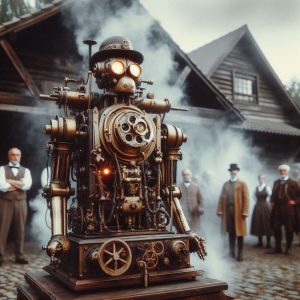
(Previous)…..(Content)…..(Next)
The first “turbulent” steps of separation
The demarcation between “Fantasy” and “Science Fiction”
(Romanian)
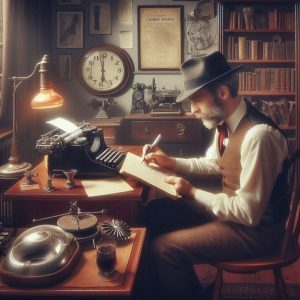
My chronological “debates” reached the period of World War II…
A period in which the “demarcations” between “Science Fiction” and “Fantasy” are becoming increasingly clearer, more certain, even through the subgenres that are taking shape more and more obviously…
But, it is also a period in which the constraints of everyday life, “acting” quite globally, were unimaginable in these times, even if only because one could conclude something like: “Who else had the urge to write science fiction? Even for propaganda!”.
A period in which censorship and self-censorship forced writers to consider the reality that many themes could (or were) considered subversive (especially when manifested in the geographical territories of the conflict) or having the “potential” to undermine the morale of the population, becoming prohibited or even “fined” (in certain “areas” even with physical elimination).
An action that could also be “indirect” either through a restriction of the themes addressed or an increase in more abstract or allegorical subjects.
Without forgetting the reality of the lack of paper and resources (the war led to a shortage of paper and other materials needed to publish books), the difficulties in distributing books (obviously, distribution chains were interrupted, making it difficult for books to reach the public) and other discouraging achievements…
However, “science fiction” during World War II continued its period of transformation, “feeding” writers with “landmarks” such as:
- Fear of the future: The war brought with it a deep fear of the future, technology, and man’s capacity for self-destruction, fears that were reflected in many of the science fiction works of the period, which often present dystopian and apocalyptic visions.
- War and Destruction: Many novels have explored the consequences of war, both on a global and personal level.
- Totalitarianism and surveillance: Totalitarian regimes have generated a fear of control and loss of individual freedom, themes that have been explored in many works of science fiction.
- Accelerated technological progress: The war accelerated the development of military technologies, such as radar, missiles, and the atomic bomb, innovations that inspired science fiction writers, who explored the potential and dangers of technology.
To which are “added” the old themes of time and space travel, as a form of escape (many writers have explored themes such as time and space travel, offering readers a perspective on the past and the future), artificial intelligence and robots (via the development of military technology that stimulated interest in artificial intelligence and the possibility of creating artificial beings), etc.
In conclusion, the period of World War II was a time of great transformation for science fiction literature. The war influenced both the themes addressed and the way these themes were presented, and science fiction writers continued to explore new worlds and ask provocative questions about the future of humanity.
But let’s proceed to a brief analysis of the novels of those times (in a somewhat chronological approach)! Taking a first step represented by approaching the most notable “Fantasy” novels of those times, creating the substrate to notice the differences between “Fantasy” and “Science Fiction”…
The nourishment of the “Fantasy” world of those times can be noted through novels such as…
The Ill‐Made Knight written by T.H. White (published in 1940) presents us with a chivalric adventure with a twist, constituting a kind of stylistic continuity of the novel “The Sword in the Stone” (1938) which, unlike his previous novel, which focuses on the formation of young Arthur, now takes us on a classic adventure, but with a unique twist.
The protagonist is not a perfect knight, but a young man with flaws and weaknesses, inexperienced, who must learn to overcome his limits, facing numerous challenges, White uses his humor and satire to parody the conventions of the chivalric novel, creating a funny and easy-to-read story.
The novel introduces us to a medieval world, a rich fantasy world, full of magic, mythical creatures, and thrilling adventures, contributing to the “description” of important lessons about courage, loyalty, and self-discovery, the novel becoming an alternative to traditional chivalric novels, White offering a fresh perspective on the genre, undermining some of its clichés.
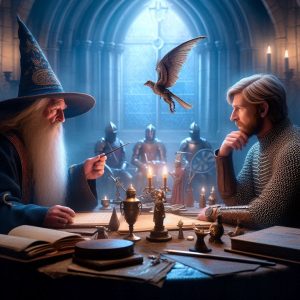
Another “Fantasy” novel is The Reign of Wizardry by Jack Williamson (1940), a fascinating work that explores the intersection of science and magic, being “descriptive” as an intriguing combination of science and magic.
Williamson introduces us to a futuristic world in which science has advanced so much that the boundary between real and magical has become blurred, the novel combines elements of science fiction and fantasy, creating a unique universe in which technology and magic coexist and influence each other, the society described in the novel being stratified and full of political intrigue, where the protagonist finds himself involved in a power struggle, raising fundamental questions about the nature of reality, the limits of human knowledge and the power of the mind.
Magic is explained through science, and wizards are people who have mastered certain laws of nature, with the protagonist joining a secret society that studies and controls magical forces, in a constant struggle for power between the different factions that want to control these magical forces.
Conjure Wife, written by Fritz Leiber, Jr. (1943) is a fascinating novel that combines elements of horror, fantasy, and science fiction in an explosive cocktail, making it an enjoyable read (an adventure full of suspense, intrigue, and complex characters) for both horror and science fiction and fantasy fans.
Leiber presents us with a seemingly ordinary world, where witchcraft is practiced in secret by women, an idea that creates an interesting contrast between the modern world and ancestral magical practices, the protagonist (Norman Saylor) is a university professor, who discovers with amazement that his wife (Tansy Saylor) is a powerful witch, involved in a secret network of magic practitioners.
The novel is full of scenes of black magic, secret rituals, and confrontations between witches, constituting itself a social satire that highlights the hypocrisy of society and traditional gender roles, presenting women as much stronger than is commonly believed.
Or the reinterpretation of fantasy through the novel The Golden Fleece (Hercules, My Shipmate), written by Robert Graves (1944), a modern reinterpretation of Greek myths, offering a psychological perspective (possibly psychoanalytic where Graves applies Sigmund Freud’s theories of psychoanalysis to interpret Greek myths) on these ancient stories, revealing hidden meanings and psychological motives for the character’s actions.
The protagonist, Jason, is not just a legendary hero, but a complex young man, with doubts and fears, whose journey (in search of the Golden Fleece, a symbol of power and knowledge, but also a search for identity and adventure) is seen as an initiatory journey, a search for identity and the meaning of life, Graves using myth to criticize aspects of modern society, such as war, power and religion.
And, even if there are other remarkable “Fantasy” achievements, let’s now proceed to fuel the Gothic world via the new novels published during this time!
A prime example would be the novel The Uninvited, by Dorothy Macardle (1942), a “modern” Gothic psychological story (at the time, considered one of the most important Gothic novels of the 20th century) which, although it seems “neither too fantasy nor too sci-fi”, borrows elements from these genres, exploring themes such as paranormal psychology or the influence of the past on the present.
The novel creates an atmosphere of suspense and mystery, placing the action in a house haunted by inexplicable events, the characters are complex and often troubled, and their actions are motivated by deeply buried desires and fears, exploring themes such as telekinesis, premonitions, and the existence of spirits, without offering scientific explanations.
The past of the haunted house and the families who lived there play a central role in the story, emphasizing the importance of history and heritage, “fueling” a story that will keep you on your toes, full of suspense and unexpected revelations.
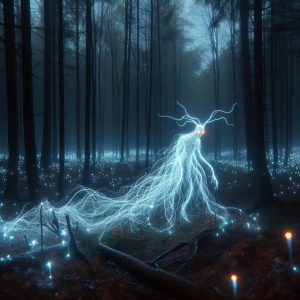
Next would be the “anthology” Gather, Darkness!, by Fritz Leiber, Jr. (1943), a collection of dark and fascinating stories (an anthology), that represents a deep exploration of dark themes and the human subconscious, the stories addressing a wide range of themes, from cosmic horror to dark psychology, in a dense and suspenseful atmosphere (in Gothic “style”, the stories being accompanied by a Gothic atmosphere, with old castles, cemeteries, and secret rituals), exploring the depths of the human psyche.
Leiber’s style (considered one of the most important writers of science fiction and fantasy) is strongly influenced by H.P. Lovecraft, and many of his stories explore themes such as cosmic horror and the existence of dark forces beyond human understanding.
Sirius: A Fantasy of Love and Discord, by Olaf Stapledon (1944) is a complex (a hidden gem in the author’s bibliography) and fascinating work, exploring deep themes of love, power, and the destiny of humanity, being a departure from the author’s usual science fiction themes, offering instead a fresco of human history and the evolution of consciousness (a captivating read, which will transport you through different eras and cultures).
Stapledon offers us a cosmic perspective on human history (from rise to decline), exploring different civilizations and cultures across millennia, with love being presented as a cosmic, universal force that can both unite and destroy, the novel explores the tensions between individual needs and societal demands, as well as the consequences of conformity.
In a sort of finale to some arguments regarding the “transition” from “Fantasy” to “Science Fiction”, recalling a kind of “linking” manifestations, we can recall the novels…
“The Winged Man”, by A.E. van Vogt and E. Mayne Hull (1944), “constitutes” itself as a combination of genres, combining elements of science fiction, fantasy, and gothic, which stands out as an epic space adventure (full of action and intrigue), as a result of an interesting collaboration between A.E. van Vogt and E. Mayne Hull, which extends van Vogt’s “tradition” of exploring themes related to human evolution, technology, and conflict (asking fundamental questions about what it means to be human and about our place in the universe).
The protagonist, a winged man (a mutant with unique flight abilities), is the result of genetic experiments and becomes a pariah in his society, exploring themes such as identity, alienation, and acceptance (searching for his place in the world and accepting himself as he is), in an epic space journey, in which the “hero” must integrate into a vast and complex universe (the novel exploring the relationships between people and how society reacts to those who are different).
Another “passing” novel would be Land of Terror, written by Edgar Rice Burroughs (1944), an exotic adventure, another jewel in Edgar Rice Burroughs’ crown, which transports us to an exotic and dangerous world, full of adventures and mysteries, an unusual cultures and customs, etc. (which will remind us of the novels of Jules Verne and H. Rider Haggard).
Burroughs creates a tropical, isolated, and dangerous world, populated by primitive tribes (an ancient and dangerous civilization) and fantastic creatures, the protagonist being an American explorer, who wakes up in this lost, mysterious world (populated by mythical and dangerous creatures, such as giant snakes and carnivorous birds), and must fight for survival (combining elements of adventure, science fiction, and fantasy), constituting itself as a subtle criticism of colonialism and the exploitation of natural resources.
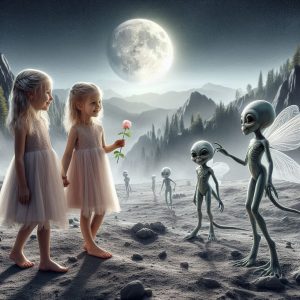
Or “children’s story” approaches, such as The Wind on the Moon, by Eric Linklater (1944), a fantastic adventure for children, that combines elements of fantasy and adventure (the novel was awarded the prestigious Carnegie Medal, an important distinction in children’s literature).
Unlike many science fiction works that present the Moon as a barren and desolate place, Linklater creates a Moon full of life and magic, where the adventurous sisters Dinah and Dorinda, the two protagonists, are brave and adventurous girls who invite us on a fantastic journey (with fantastic creatures and spectacular landscapes), where they face a tyrant and save a magical creature.
The novel combines real-world elements with fantastical elements, creating a captivating and imaginative story, but also introducing a subtle critique of authority and social conventions.
The “number” of “Fantasy” novels of those times is much higher than that of “Science Fiction” novels, “discussing” a kind of transition from the “F-SF (Fantasy – Science Fiction)” genre to what would become SF-F, but…
The transition to the “quantitative” (possibly also “qualitative”) predominance of “Science Fiction” versus “Fantasy” will take a long time, either through the acceptance that future video games will “regenerate” the “renewed” presence of the old “Fantasy” themes, or through the fact that children and young people will mostly prefer these elements, to the detriment of “Science Fiction”, but…
It is a “matter of taste” that will be greatly affected by the predominant influence of the “image” on the imagination, via the “Big Screen” and/or television (not to mention the monitor, as a “peripheral” of a computer or a game console)…
Merticaru Dorin Nicolae


